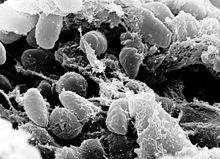Yersinia pestis
| Yersinia pestis | |
|---|---|
 |
|
| A scanning electron micrograph depicting a mass of Yersinia pestis bacteria in the foregut of an infected flea | |
| Scientific classification | |
| Domain: | Bacteria |
| Kingdom: | Eubacteria |
| Phylum: | Proteobacteria |
| Class: | Gammaproteobacteria |
| Order: | Enterobacteriales |
| Family: | Enterobacteriaceae |
| Genus: | Yersinia |
| Species: | Y. pestis |
| Binomial name | |
|
Yersinia pestis (Lehmann & Neumann, 1896) van Loghem, 1944 |
|
| Synonyms | |
|
Bacillus
|
|
Bacillus
Yersinia pestis (formerly Pasteurella pestis) is a Gram-negative, rod-shaped coccobacillus, a facultative anaerobic organism that can infect humans via the oriental rat flea. It causes the deadly disease called bubonic plague (or "the plague" colloquially). Human Y. pestis infection takes three main forms: pneumonic, septicemic, and bubonic plagues. All three forms were responsible for a number of high-mortality epidemics throughout human history, including: the sixth century's Plague of Justinian; the Black Death, which accounted for the death of at least one-third of the European population between 1347 and 1353; and the 19th century's Third Pandemic. These plagues probably originated in China and were transmitted west via trade routes.
Y. pestis was discovered in 1894 by Alexandre Yersin, a Swiss/French physician and bacteriologist from the Pasteur Institute, during an epidemic of the plague in Hong Kong. Yersin was a member of the Pasteur school of thought. Kitasato Shibasaburō, a German-trained Japanese bacteriologist who practised Koch's methodology, was also engaged at the time in finding the causative agent of the plague. However, Yersin actually linked plague with Y. pestis. Named Pasteurella pestis in the past, the organism was renamed Yersinia pestis in 1944.
...
Wikipedia
